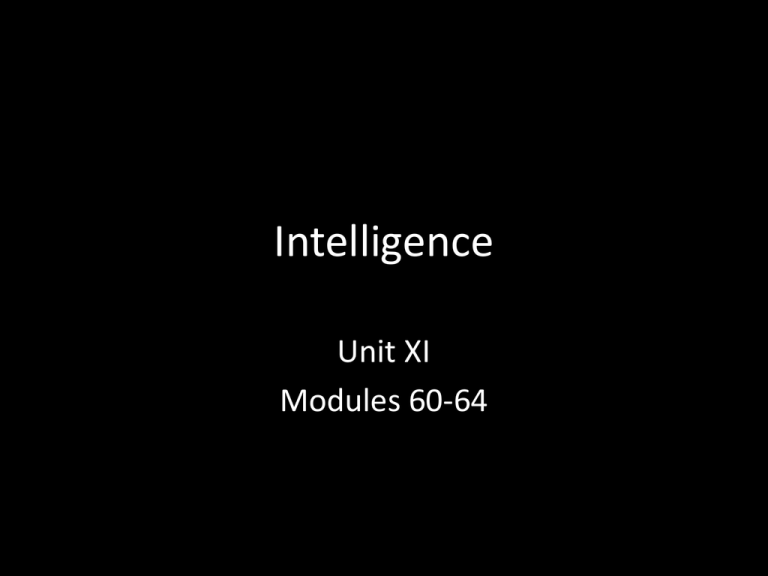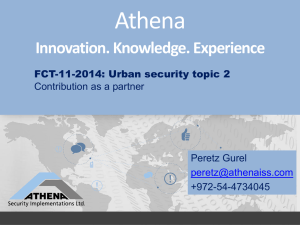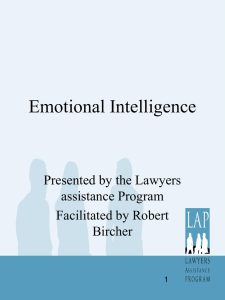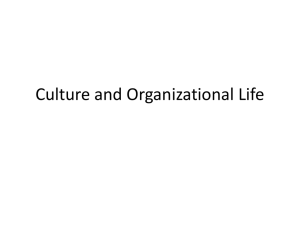Intelligence
advertisement

Intelligence Unit XI Modules 60-64 Intelligence • One of the biggest debates about intelligence is about if intelligence is one aptitude or many • In past research studies, intelligence has been operationally defined as whatever intelligence tests measure, which has tended to be school smarts • Intelligence is not a quality like height or weight that has the same meaning to everyone around the world • People assign the term intelligence to the qualities that enable success in their own time and in their own culture * Intelligence • Intelligence- mental quality consisting of the ability to learn from experience, solve problems, and use knowledge to adapt to new situations • Intelligence test- a method for assessing an individual’s mental aptitudes and comparing them with those of others using numerical scores * Intelligence • You probably know people that are really talented at one or a few things, but struggle to succeed in other areas in the most basic ways • Are all these people intelligent even though struggle badly in something? • Can you rate someone’s intelligence on one single scale or do you need several different scales * Intelligence • Charles Spearman believed we have one general intelligence – (g)- a general intelligence factor that, according to Spearman and others underlies specific mental abilities and is therefore measured by every task on an intelligence test • In order to test the general intelligence, Spearman helped develop factor analysis – A statistical procedure that identifies clusters of related items called factors on a test – Used to identify different dimensions of performance that underlie a person’s total score * Intelligence • Spearman found that those who score high in one area like verbal intelligence usually score higher than average in other areas such as spatial or reasoning ability • Spearman believed a common skill set, the g factor, underlies all intelligent behavior • L.L. Thurstone worked to disprove Spearman’s idea of a g factor • He identified seven clusters of primary mental abilities • He did not rank people on a single scale of general aptitude * Intelligence • When other researchers studied Thurstone’s seven clusters they found that those who excelled in one of the seven clusters generally scored well on the others • This supported the idea of a g factor • We can liken mental ability to physical ability • Athleticism is not on thing but many • Maybe there is a general athletic ability to allows some to run fast and catch a ball well also • These are two very different talents that some people are equally good at * Theories of multiple intelligences • Howard Gardner views intelligence as multiple abilities that come in different packages • Brain damage can destroy one ability while keeping others intact • He looked at people with savant syndrome to study his ideas – Savant syndrome- a condition in which a person otherwise limited in mental ability has an exceptional specific skill, such as in computation or drawing * Videos of Savant syndrome Theories of multiple intelligences • People with savant syndrome often score low on intelligence tests but have an island of brilliance • Some have virtually no language ability but can compute numbers and figures as quickly as a calculator • Sometimes they can identify the day of the week with a historical event • About 4 in 5 who are savant are male and many also have autism spectrum disorder * Theories of multiple intelligences • Using his studies about savant syndrome, Gardner argued that we do not have an intelligence but multiple intelligences • If someone is talented at many things, its not because they have a common intelligence trait but instead they exhibit multiple intelligences • Recent research has gone against Gardner and supported the idea of a general intelligence * Theories of multiple intelligences • Recent studies have shown that the g factor does matter and it predicts performance on various complex tasks and in various jobs • Success is not a one ingredient recipe • High intelligence may help you get into a good college but it wont make you successful once there • The recipe for success combines talent with grit – Grit is passion and perseverance in the pursuit of long term goals * Theories of multiple intelligences • Robert Sternberg agrees that there is more to success than traditional intelligence and also agrees with Gardner’s idea of multiple intelligences • Sternberg proposes a triarchic theory of three, not eight, intelligences * Theories of multiple intelligences • Sternberg’s three intelligences are: • Analytical intelligence- assessed by traditional intelligence tests which present well defined problems having a single right answer- such tests can usually predict school grades fairly well • Creative intelligence- demonstrated in reacting adaptively to novel situations and generating novel ideas • Practical intelligence- required for everyday tasks, which may be ill-defined with multiple solutionscan help predict managerial success * Theories of multiple intelligences • Sternberg has helped to develop new measures of creativity that have been seen to be better at predicting success of American students in their first year of college with reduced ethnic-group differences • Gardner and Sternberg differ on some points but they both agree that multiple abilities can contribute to life success • Under their influences, teachers are taught to value a variety of learning styles and to apply multiple intelligence theory to their classroom * Emotional Intelligence • Social intelligence is distinct from academic intelligence • Social intelligence is the know how involved in successfully comprehending social situations • People with high social intelligence can usually properly read social situations and respond accordingly • Edward Thorndike first proposed the idea of social intelligence • Later psychologist found that people with high IQs did not seem to be performing higher in social situations * Emotional Intelligence • Emotional intelligence- the ability to perceive, understand, manage, and use emotions • A test has been developed to assess the four emotional intelligence components: – Perceiving emotions – Understanding emotions – Managing emotions – Using emotions * Emotional Intelligence • Emotional intelligence is less a matter of conscious effort than of one’s unconscious processing of emotional information • Those who score higher on emotional intelligence tests usually enjoy higher quality interactions with friends • They may exhibit better job performance • They tend to be able to stay away from depression, anxiety, or anger * Is Intelligence neurologically measurable? • Studies have shown there to be a correlation of +.33 between brain size and intelligence • What does this correlation mean? • It does show a correlation to exist between brain size and intelligence- the larger the brain the higher the intelligence • Remember its only a correlation * Is Intelligence neurologically measurable? • Further brain imaging studies have shown that intelligence is having ample gray matter(mostly neural cell bodies) plus ample white matter(axons) that make for efficient communication between brain centers • In some studies, like with Einstein’s brain, they found certain areas of the brain to be larger than normal • In Einstein, his parietal lobe was 15 percent larger- this area is the center for processing mathematical and spatial information * Is Intelligence neurologically measurable? • Brain scans also reveal that smart people use less energy to solve problems • Basically it has been seen that the brains of smart people seem to work more efficiently and more quickly * Origins of intelligence testing • Western cultures have pondered how and why individuals differ in mental activity • Francis Galton did a lot of research on human traits • Galton was Darwin’s cousin and Galton wanted to see if he could test natural ability • Galton would also suggest that people of high ability mate together to rid the world of the less diserable people- called eugenics * Origins of intelligence testing • Galton’s attempts to discover a way to measure natural ability failed • He did help create the nature vs nurture argument that we still look at in psychology today * Origins of intelligence testing • The modern intelligence testing movement began at the beginning of the 20th century when France passed a law requiring all children to attend school • Some of the children seemed incapable of benefiting from the regular school curriculum and in need of special classes • The schools were in need of an objective way to determine what kids were in need of the special classes * Alfred Binet • The schools did not trust the subjective judgments of teachers • To minimize bias from teachers, France commissioned Alfred Binet to study the problem • Binet assumed that all children follow the same course of intellectual development but that some develop more rapidly * Alfred Binet • A dull child should perform as does a typical younger child on tests and a bright child should perform as does a typical older child • Binet wanted to measure a child’s mental age – The chronological age that most typically corresponds to a give level of performance – A child who does as well as the average 8 year old is said to have a mental age of 8 • If a 9 year old performs at the level of a typical 7 year old, they would struggle with age appropriate schoolwork according to Binet * Alfred Binet • Binet would test a variety of reasoning and problem solving questions on his daughters and then on bright and backward Parisian children- standardization for his tests • By testing these children he identified items that would predict how well French children would handle their schoolwork * Alfred Binet • Professionally Binet did not make assumptions concerning why a particular child was slow, average, or advanced • Personally Binet leaned more towards an environmental reasons • To raise the capacities of low scoring children he recommended mental orthopedics that would help develop their attention span and self discipline * Alfred Binet • Binet believed his intelligence test did not measure inborn intelligence but it did identify French schoolchildren that needed special attention • Binet feared his tests would be used to label children and limit their opportunities instead of helping children that needed help * Lewis Terman and IQ • Soon after Binet’s death, people adapted his tests for use as a numerical measure of inherited intelligence • Lewis Terman, a professor at Stanford, was one of the first to do this • Terman found that the Paris developed questions and age norms did not work well with California schoolchildren * Lewis Terman and IQ • Terman’s revision of Binet’s test would be called the Stanford-Binet Intelligence Test • For Terman, intelligence tests revealed the intelligence with which a person was born • William Stern would use the tests to develop the intelligence quotient or IQ – Defined originally as the ratio of mental age to chronological age multiplied by 100(IQ=ma/ca X 100) – On contemporary intelligence tests the average for performance for a given age is assigned a score of 100, with scores assigned to relative performance above or below average * Lewis Terman and IQ • What would an 8 year old who answers questions as would a typical 10 year have for an IQ? • 125 • The original IQ formula worked well for children but not adults • Today’s Stanford-Binet tests compute IQ differently • The IQ scores represent the test takers performance relative to the average performance of others the same age • 2/3 of people fall between 85 and 115 with 100 being average * Lewis Terman and IQ • Terman agree with Galton’s ideas of eugenics • He believed that intelligence tests would ultimately result in curtailing the reproduction of feeblemindness and in the elimination of an enormous amount of crime and industrial inefficiency • With Terman’s help, the US government developed new tests to evaluate both newly arriving immigrants and WWI army recruits * Lewis Terman and IQ • The results of the tests indicated the inferiority of people not sharing their AngloSaxon heritage • This led to a 1924 immigration law that reduced Southern and Eastern European immigration quotas to less than 1/5 of those for Northern and Western Europe • Binet would have been horrified to see how his tests were being used * Modern Tests of Mental Ability • Achievement tests- a test designed to assess what a person has learned – AP exams, final exams • Aptitude test- a test designed to predict a person’s future performance – Aptitude is the capacity to learn – College entrance exams • Total scores on the US SAT correlated +.82 with general intelligence scores in a national sample of 14 to 21 year olds * Modern Tests of Mental Ability • Wechsler Adult Intelligence Scale(WAIS)- contains verbal and performance(nonverbal) subtests – Most widely used individual intelligence test – WISC- Wechsler Intelligence Scare for Children – Includes 15 subtests including similarities, vocabulary, block design, and letter number sequencing – It yields an overall intelligence score and a separate score for verbal comprehension, perceptual organization, working memory, and processing speed – Can show weaknesses in people to help know what the student needs help in * Test Construction • To be widely accepted, psychological tests must meet three criteria – Standardized, reliable, and valid • Just seeing how many questions you get right on a test does not tell us anything • We need a basis for comparing your score with others’ performance • Test-makers first give the test to a representative sample of people to gain meaningful comparisons * Test Construction • Your score is then compared to the scores of others to see your position relative to others • Standardization- defining uniform testing procedures and meaningful scores by comparison with the performance of a pretested group • Normal curve- the symmetrical, bell-shaped curve that describes the distribution of many physical and psychological attributes – Most scores fall near the average, and fewer and fewer scores lie near the extremes – The midpoint for intelligence is 100 * Test Construction • To keep the average score near 100, the Stanford-Binet and Wechsler scales are periodically restandardized • Flynn effect- intelligence test performance has been improving over time – The cause of this increase is unknown * Test Construction • Reliability- the extent to which a test yields consistent results as assessed by the consistency of scores on two halves of the test, on alternate forms of the test, or on retesting • If the two scores generally agree the test is considered to be reliable • The higher the correlation between the testretest scores, the higher the test’s reliability • The Stanford-Binet and WAIS have a reliability of +.9 * Test Construction • High reliability does not ensure a test’s validity • Validity- the extent to which a test measures or predicts what it is supposed to • If you use an inaccurate tape measure to measure people’s heights, your height report would have high reliability but low validity • Content validity- the extent to which a test samples the behavior that is of interest * Test Construction • The road test for a driver’s license has content validity because it samples the tasks a driver routinely faces • Predictive validity- the success with which a test predicts the behavior it is designed to predict – It is assessed by computing the correlation between test scores and the criterion behavior * Test Construction • The predictive power of aptitude tests is fairly strong in the early school years, but later it weakens * Stability or Change? • How stable are people’s intelligence scores throughout their lives? • Do people gradually decline intellectually as we do physically? • In cross sectional studies researchers are able to test and compare people of various ages at one time • In these studies, researchers have consistently found that older adults give fewer correct answers on intelligence tests than do younger adults * Stability or Change? • Wechsler stated that he thought the decline of mental ability with age was a part of the general aging process of the organism(human) as a whole • For a long time, his opinion was not challenged • Corporations established mandatory retirement policies, assuming companies would benefit from replacing old workers with young ones * Stability or Change? • In the 1920s, some psychologists decided to study college students longitudinally • They retested the same cohort over a period of years – Cohort- a group of people from a given time period • They found that until late in life, intelligence remained stable • In some cases it even increased * Stability or Change? • Why the difference in the two studies? • The cross sectional studies were studying 2 groups of people from different ages but also different eras • They compared less educated people from the early 1900s with better educated people born after 1950 – They also looked at people raised in large families compared to smaller families – People in less affluent homes to people raised in more affluent homes * Stability or Change? • With the new findings, the idea that intelligence sharply declines with age was found to not be accurate • They also found possible problems in the longitudinal studies • Those that survived to be retested were those that were bright and healthy so they were most likely to survive the study * Stability or Change? • Crystallized intelligence- our accumulated knowledge and verbal skills – Tends to increase with age • Fluid intelligence- our ability to reason speedily and abstractly – Tends to decrease during late adulthood • So basically our intelligence increases and decreases depending on the type of intelligence that is being tested 8 Extremes of Intelligence • At one extreme of the normal curve are those with unusually low intelligence test scores • Intellectual disability- a condition of limited mental ability, indicated by an intelligence score of 70 or below and difficulty in adapting to the demands of life- formerly called mental retardation • Performance is usually two standard deviations below average • Intellectual disability is usually apparent before age 18 * Extremes of Intelligence • Down syndrome- a condition of mild to severe intellectual disability and associated physical disorders caused by an extra copy of chromosome 21 * Extremes of Intelligence • Terman studied a large population of children in California that IQ scores were over 135 • Terman found the children to be healthy, well adjusted, and unusually successful academically • Before his studies people thought they were maladjusted * Extremes of Intelligence • Many people question the assumptions of the “gifted and talented” programs in schools • One is the belief that only 3 to 5 percent of children are gifted and that it pays to identify and track these special few • Tracking- segregating them in special classes and giving them academic enrichment not available to their peers • Critics say tracking by aptitude often creates a self-fulfilling prophecy * Twin and adoption studies • • • • • Intelligence does run in families Is this nature or nurture? How can you study this issue? Twin and adoption studies The intelligence test scores of identical twins raised together are virtually as similar as those of the same person taking the same test twice • The scores of fraternal twins are much less similar Twin and adoption studies • Heritability- the proportion of variation among individuals that we can attribute to genes • The heritability trait may vary, depending on the range of populations and environments studied Group differences in intelligence test scores • Stereotype threat- a self-confirming concern that one will be evaluated on a negative stereotype • In a study, when African-American students were reminded of their race before taking a verbal test, they performed worse • While taking a test, if you are worried about the stereotype that your group does not perform well, it may affect your performance









